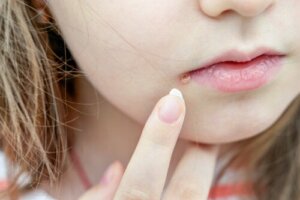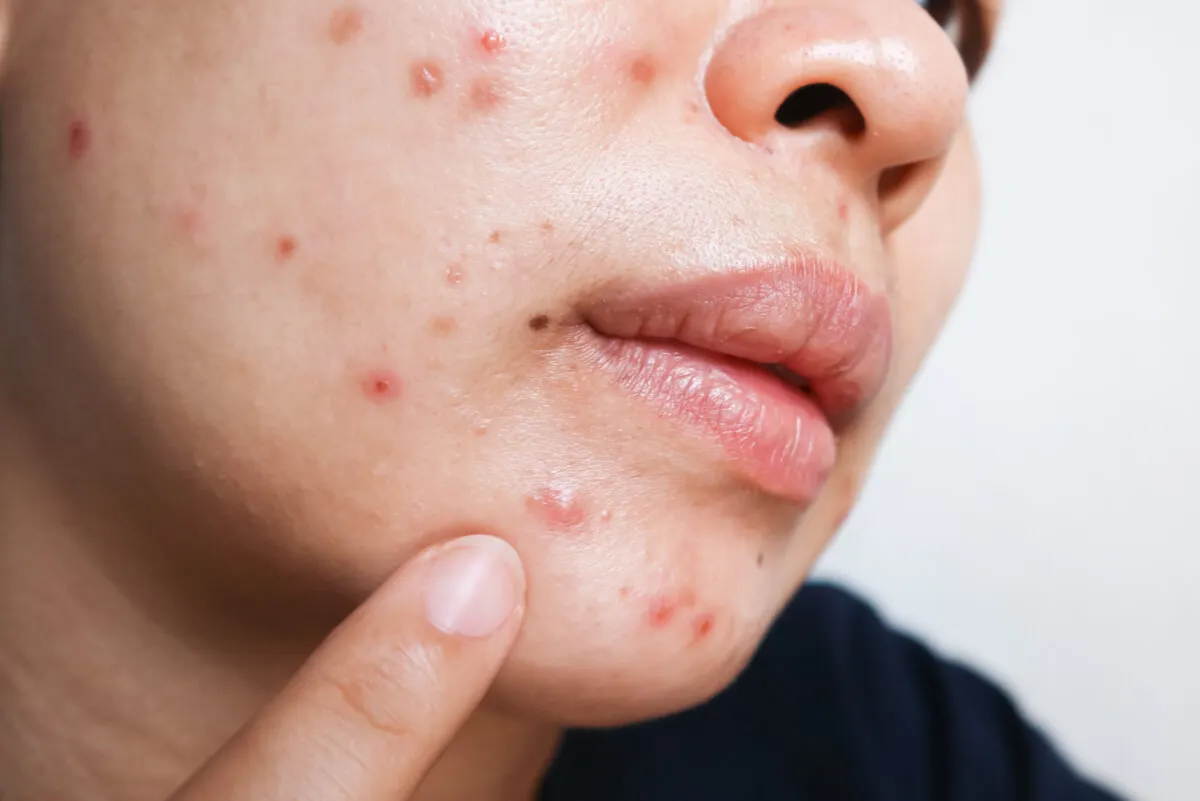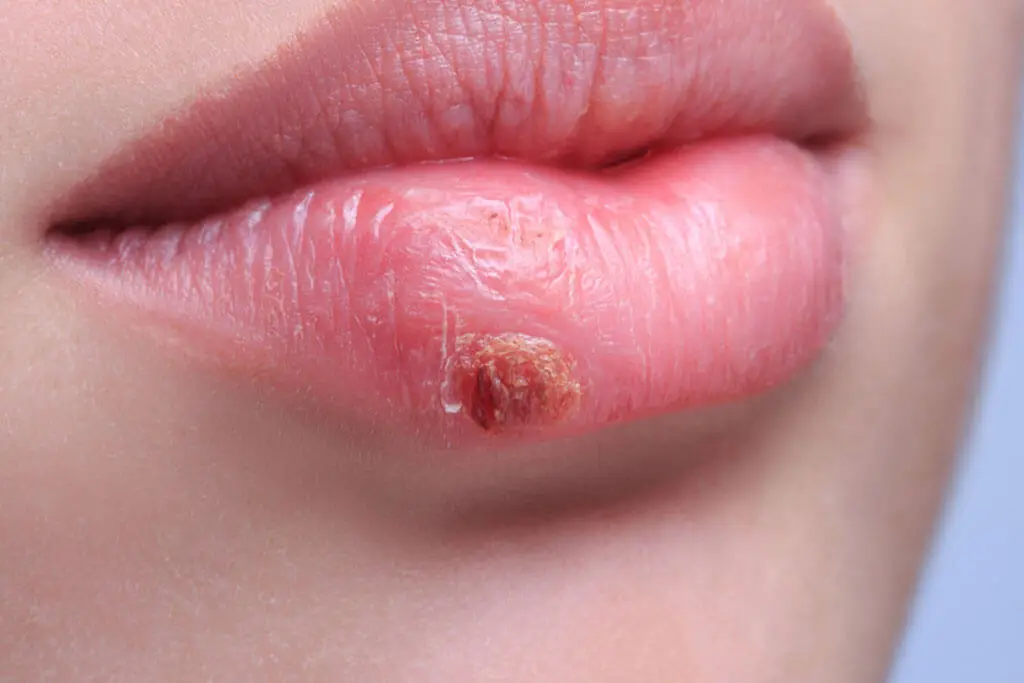How to Tell The Difference Between a Pimple and a Cold Sore

The difference between a pimple and a cold sore can be a crucial question when you wake up in the morning and notice a slightly painful red bump near your lip. Although they are very different skin problems, they can look very similar at first.
Asking yourself this question is crucial. It’s not just a matter of curiosity, but recognizing the difference is the key to treatment. In this article, we’ll look at both types: herpes cold sores and acne pimples. Then, we’ll teach you how to distinguish between them based on their characteristics.
The characteristics of pimples
Pimples or blackheads occur when a pore becomes blocked due to oil and the accumulation of dead cells. Then, bacteria on the skin enter the pore, and an infection occurs.
Shortly before a pimple appears, it can often be felt as a small bump under the skin that’s tender to the touch. Then, the pimple manifests itself in the form of a red bump. Within days, a spot of pus often shows up. Pimples can appear almost anywhere on the skin of the face: the forehead, nose, cheeks, and even on the edge of the lips.
It’s not always possible to differentiate between a pimple and herpes when it comes to the lips. However, pimples do not appear on the vermilion of the lip (the bulging area where lipstick is applied) but reach only up to the white line.
Acne is quite common. In adolescence, almost everyone has pimples or blackheads. However, there is also acne in adults. Although it’s not contagious, acne can spread on the face if we don’t take precautions. In this sense, it’s recommended that the person doesn’t touch the pimples, since the bacteria can spread.
You might like this article: Hormonal Acne, the Causes and Treatment Options

How to identify a cold sore
Any infection caused by the herpes simplex virus (HSV) is generally simply called “herpes” or a “cold sore.” It can affect different areas of the body, but is has a preference for mucous membranes.
Cold sores can be transmitted by saliva or by contact with infected people. It should be noted that it is very easily spread and is quite common. It’s estimated that 70% of people suffer from it at some time.
Although it doesn’t always cause outbreaks, it most commonly manifests itself in the form of one or more blisters. These are red. One way to tell the difference between a pimple and a cold sore is by the bubbly appearance of the latter.
On the other hand, cold sores can form directly on the upper lip. However, a cold sore may also appear around the mouth, under the lower lip, or between the mouth and the nose.
As for the symptoms, herpes is slightly painful, it burns, and the skin around it often feels tight. These sensations may be experienced even moments before it appears. Eventually, the blisters burst, oozing fluid. Then, a crust forms and falls off.
We think you’ll like to read: Is There a Relationship Between Diet and Acne?
The differences between a pimple and a cold sore
While there are some similarities between these two, it’s possible to tell the difference between a pimple and a cold sore. Let’s look at what makes them different.
Shape
When it appears, a cold sore is a bubble, but when several of them together, they may look like a cluster of islands. In comparison, a pimple is a bump with a more rounded shape.
Color
When it appears, herpes is a clear and pearly color. Meanwhile, a pimple appears rather red, like an irritation.
Later, herpes becomes yellowish. In turn, a pimple at maturity shows a white spot.
Location
Pimples can appear on the edge of the lip, but never inside. This is one of the features that best differentiates between a pimple and herpes.
Texture
At first, herpes is soft and yields to the touch, although it should not be touched. As it dries, it becomes rough; it becomes a dry crust, like a wound. Meanwhile, the texture of a pimple is more like skin, although the pus when it comes out is soft.
Duration
With cold sores, the blisters may remain for several days until they break and scab over. In total, a cold sore may last for 2 to 3 weeks.
On the other hand, the duration of a pimple can vary between 3 and 7 days if it’s not touched or squeezed. Otherwise, it can remain irritated for more than a week.
Consequences
Herpes disappears without leaving marks or scars, although it can reappear in the same place. On the other hand, pimples can leave marks in the form of holes, grooves, or scars, especially when they’re scratched or popped.
Reactivation
After the first infection, HSV remains inactive but dormant in the body for life. It tends to reactivate due to stress, immune system disturbances, or fever. However, it may not come back.
Treatment of pimples and cold sores
In the case of cold sores, the outbreak subsides on its own over time. However, there are antiviral medications to help alleviate the discomfort, if necessary.
These, if taken at the beginning of an outbreak, can reduce the severity and duration of the episode. There are also natural treatments for cold sores that include black tea, yogurt, tomato, baking soda, and honey.
Lip balms and ointments are also helpful to prevent the appearance of dryness and cracking. Something very important to remember is that these medicines should be applied with a cotton swab, not with the fingers.
Meanwhile, there are several alternatives for pimples. In general, topical treatment of acne is often based on creams and ointments with salicylic acid, alpha-hydroxy acids, and benzoyl peroxide, among other agents.

Can pimples and cold sores be prevented?
In the case of pimples, it could be said that some triggers of acne outbreaks are controllable. Hence, as a starting point, maintaining proper skin cleanliness and decreasing your consumption of high-fat foods are considered good measures. However, recently the relationship between diet and acne has been questioned.
For cold sores, measures should be taken to prevent them from spreading, both in the same person and in the contagion to others. That said, it’s very important to avoid popping or touching the sores, kissing others, or using shared objects when there’s an outbreak.
Also, if you’re a person prone to suffering from cold sores, it’s a good idea to take note of the circumstances or events that trigger outbreaks. This will make it easier to prevent or avoid them.
All cited sources were thoroughly reviewed by our team to ensure their quality, reliability, currency, and validity. The bibliography of this article was considered reliable and of academic or scientific accuracy.
- Aguilar L, Giménez M, Prieto J. (2005). ¿Es necesaria la prevención de la reactivación del virus herpes simple tipo 1 en cirugía estética y en procedimientos dermatológicos? Rev Esp Quimioterap. 2005; 18(2): 118-123.
- Bagatin, E., Et al. (2019). Adult female acne: a guide to clinical practice. An Bras Dermatol. 2019; 94(1): 62-75.
- Barrientos S, Velosa J, Rodríguez A., (2014). Prevalencia de herpes labial recurrente en población de 18 a 30 años de edad en Bogotá.Colombia Universitas Odontológica. 2014; 33(71): 19-27.
- Crimi S., Et al., (2019) Herpes virus, oral clinical signs and QoL: Systematic review of recent data. Viruses. 2019; 11(5): 463. doi:10.3390/v11050463
- Dreno B, Bagatin E, Blume-Peytavi U, Rocha M, Gollnick H., (2018). Female type of adult acne: Physiological and psychological considerations and management. J Dtsch Dermatol Ges. 2018; 16(10):1185-1194.
- Dréno, B., (2015). Treatment of adult female acne: a new challenge. J Eur Acad Dermatol Venereol. 2015; 29(5):14-19.
- El Ahmed, H., (2015). Management of acne vulgaris with hormonal therapies in adult female patients. Dermatol Ther. 2015; 28(3): 166-172.
- Kaye K. (S.F). Infecciones por el virus del herpes simple (VHS). MSD Manuals. Consultado el 22 de febrero de 2023. https://www.msdmanuals.com/es-ve/hogar/infecciones/infecciones-por-el-virus-del-herpes/infecciones-por-el-virus-del-herpes-simple-vhs
- Ramos Silva M, Ramos Silva S, Carneiro S. Acne in women. Br J Dermatol. 2015; 172 (Suppl 1): 20-26.
- Diez de Medina, J. (2009). Manejo racional del acné. Revista de la Sociedad Boliviana de Pediatría, 48(1), 24-30. http://www.scielo.org.bo/scielo.php?script=sci_arttext&pid=S1024-06752009000100007&lng=es&tlng=es.
- Chi, C., (2015). Herpes labialis. BMJ Clinical Evidence, 2015, 1704. https://www.ncbi.nlm.nih.gov/pmc/articles/PMC4632913/
- Guerrero-Zulueta, A. (2015). Acné. Revista de Atención Familiar, 20(1), 30-31. https://www.elsevier.es/es-revista-atencion-familiar-223-articulo-acne-S1405887116300426
- Bascones-Martínez, A., & Pousa-Castro, X. (2011). Herpesvirus. Avances en Odontoestomatología, 27(1), 11-24. http://scielo.isciii.es/scielo.php?script=sci_arttext&pid=S0213-12852011000100002&lng=es&tlng=es.
- Giménez, S. (2004). Herpes, clínica y tratamiento. Farmacia Profesional, 18(8), 42-48. https://dialnet.unirioja.es/servlet/articulo?codigo=4583628
- Martínez G., M. J. (2011). Infecciones virales en piel y mucosas. Revista Médica Clínica Las Condes, 22(6), 795-803. https://www.sciencedirect.com/science/article/pii/S0716864011704928
- Opstelten, W., Neven, A. K., & Eekhof, J. (2008). Treatment and prevention of herpes labialis. Canadian family physician Medecin de famille canadien, 54(12), 1683–1687. https://www.ncbi.nlm.nih.gov/pmc/articles/PMC2602638/
- Hantz, S., & Alain, S., (2018). Infecciones por el virus del herpes simple. EMC – Pediatría. Volume 53, Issue 2, June 2018, Pages 1-13. https://www.sciencedirect.com/science/article/abs/pii/S1245178918897220
- Guerra, T., Et al. (2015). Consenso en el tratamiento tópico del acné. Med Cutan Iber Lat Am 2015; 43 (2). https://www.medigraphic.com/cgi-bin/new/resumen.cgi?IDARTICULO=61833
This text is provided for informational purposes only and does not replace consultation with a professional. If in doubt, consult your specialist.








